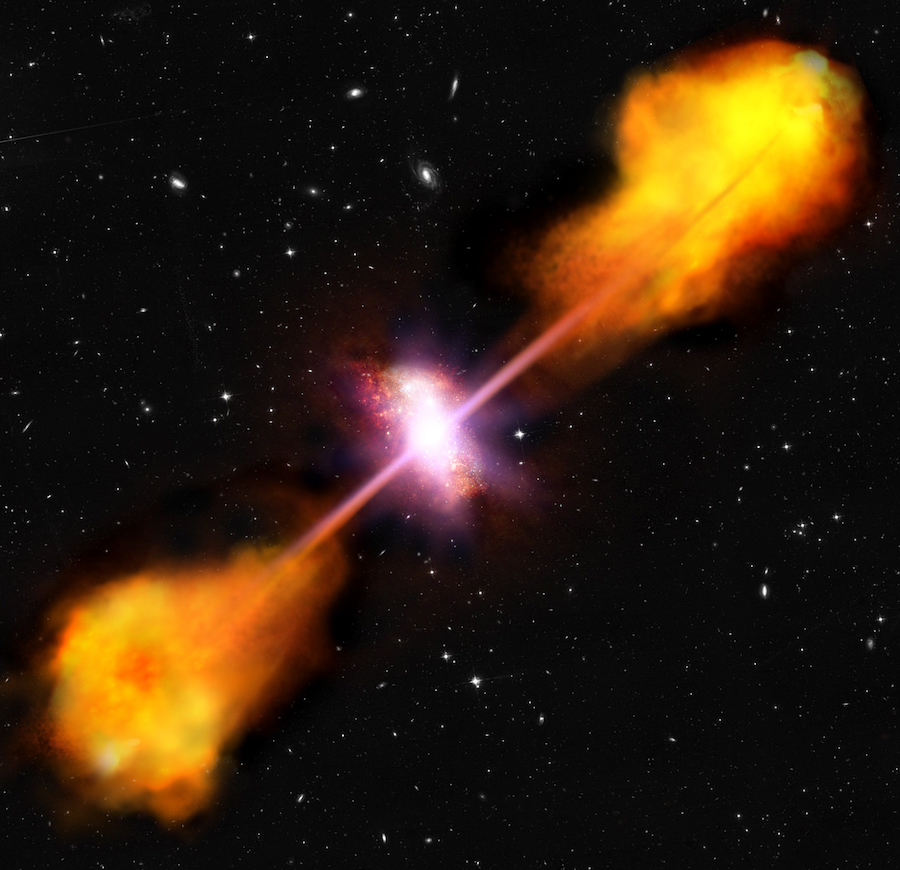Zwarte gaten eten graag, maar hebben verschillende tafelmanieren
Alle superzware centrale zwarte gaten in sterrenstelsels blijken periodes te hebben dat ze materie uit hun nabije omgeving verorberen. Maar verder houden de overeenkomsten wel zo'n beetje op. Dat blijkt uit onderzoek van sterrenkundigen uit Groningen, Manchester en Pretoria met ultra-gevoelige radiotelescopen aan een extreem goed bestudeerd stuk heelal. Ze publiceren hun bevindingen binnenkort in twee artikelen in het internationale vakblad Astronomy & Astrophysics.
Sinds de jaren vijftig van de vorige eeuw bestuderen sterrenkundigen al zogeheten actieve sterrenstelsels. Dat zijn sterrenstelsels met een superzwaar zwart gat in hun centrum dat materie aan het verorberen is. Daarbij komen onder andere intense radiostraling, uv-straling, en röntgenstraling vrij.
In twee nieuwe publicaties die binnenkort verschijnen, heeft een internationaal team van astronomen alle actieve sterrenstelsels van het extreem goed bestudeerde GOODS-North-gebied in het sterrenbeeld Grote Beer nog eens extra onder de loep genomen. Tot nu toe was het gebied vooral bestudeerd met ruimtetelescopen die zichtbaar licht, infrarood licht en uv-licht opvingen. De nieuwe waarnemingen voegen daar gegevens van netwerken van radiotelescopen aan toe, waaronder het e-MERLIN-netwerk in Engeland en het Europese VLBI-netwerk met zijn centrum in Dwingeloo.
Dankzij de systematische studie worden drie zaken duidelijk. Ten eerste blijkt dat in veel verschillende soorten sterrenstelsels de kern actief kan zijn en dat de zwarte gaten soms een overvloed aan materie naar binnen werken maar soms ook bijna omkomen van de honger.
Ten tweede gaat een actieve kern soms samen met stervorming, en soms niet. En als er sprake is van stervorming, dan is de activiteit in de kern lastig te meten.
Ten derde genereren de actieve kernen van sterrenstelsels soms wel en soms geen radiostraling. De immens grote, spectaculaire radiostructuren kunnen ontstaan ongeacht de snelheid waarmee het zwarte gat zijn eten naar binnen werkt.
Volgens onderzoeksleider Jack Radcliffe (voorheen Rijksuniversiteit Groningen, Universiteit van Manchester en ASTRON, nu Universiteit van Pretoria, Zuid-Afrika) laten de waarnemingen verder zien dat radiotelescopen heel geschikt zijn om de eetgewoonten van zwarte gaten in het verre heelal in kaart te brengen. "Dat is goed nieuws, want de SKA-radiotelescopen komen eraan en daarmee kunnen we met nog meer detail diep het heelal in kijken."
Medeauteur Peter Barthel (Rijksuniversiteit Groningen) voegt toe: "We krijgen steeds meer aanwijzingen dat alle sterrenstelsels enorm zware zwarte gaten hebben. Die moeten natuurlijk ooit gegroeid zijn. Het lijkt erop dat we dankzij onze waarnemingen deze groeiprocessen nu in beeld hebben en langzaam maar zeker gaan begrijpen."
Medeauteur Michael Garrett (Universiteit van Manchester, Groot-Brittannië) vult aan: "Deze prachtige resultaten laten weer eens de unieke capaciteiten van de radiosterrenkunde zien . Radiotelescopen leveren een nieuwe kijk op de evolutie van sterrenstelsels in het vroege heelal."

Meer nieuws
-
09 december 2025
RUG-hoogleraar bij COP30: ‘Het is altijd drama’
-
02 december 2025
Student Menna Zahran wint Unilever Research Prize
-
27 november 2025
Vliegtuigen spotten met een radiotelescoop
